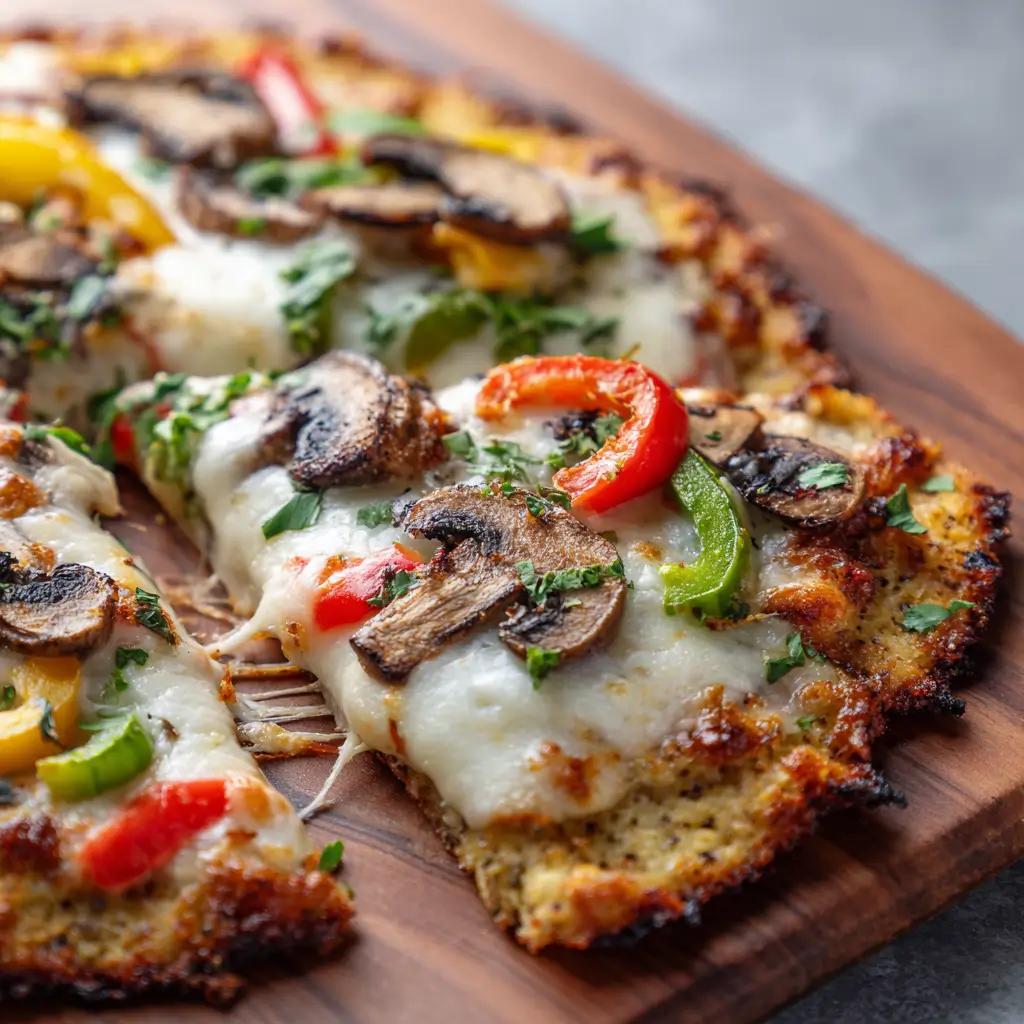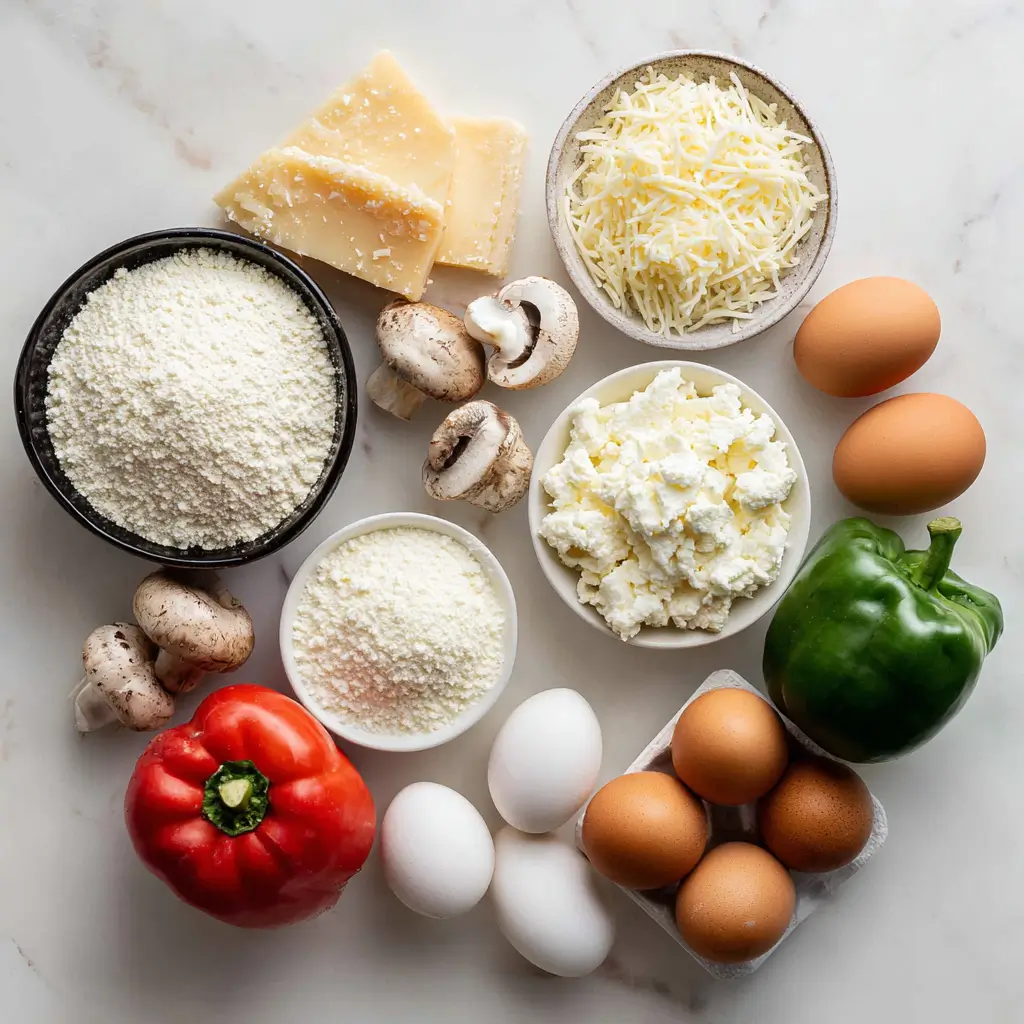The craving for pizza never really goes away, even when you’re following a low-carb lifestyle. That’s where Keto Pizza comes in—offering all the flavors of traditional pizza, without the carb-heavy crust. This recipe swaps regular flour for almond flour, pairs it with creamy mozzarella, and layers it with keto-friendly toppings. In this article, we’ll explore not only how to make the perfect keto pizza at home but also its health benefits, variations, toppings, and frequently asked questions. We’ll cover everything from step-by-step preparation to nutritional breakdown, so by the end, you’ll have a complete guide to enjoying pizza while staying on track with your keto goals.

Table of Contents
Table of Contents

Keto Pizza
Ingredients
Method
- Preheat the oven to 400°F (200°C) and grease a baking sheet.
- Whisk almond flour to remove clumps and set aside.
- In a microwave-safe bowl, melt mozzarella cheese and cream cheese in short bursts until smooth.
- Stir in almond flour, then add eggs, mixing until a sticky dough forms.
- Roll the dough between parchment paper into a round crust about ½ inch thick.
- Bake the crust for 12 minutes until golden and firm.
- Spread keto pizza sauce over the crust, then sprinkle mozzarella, mushrooms, and bell peppers on top.
- Season with Italian seasoning and bake another 10–12 minutes until bubbly and crisp.
- Slice and serve hot.
Nutrition
Notes
Tried this recipe?
Let us know how it was!What is Keto Pizza?
Understanding Keto Pizza
Keto pizza is a low-carb version of traditional pizza, designed for those following the ketogenic diet. Instead of a wheat-based crust, it uses almond flour and cheese to create a firm, flavorful base. This keeps carbs low while still providing a satisfying texture. Unlike cauliflower crusts, this version holds together better and mimics the chewy bite of classic pizza.
Why Choose Keto Pizza Over Regular Pizza
Regular pizza can pack over 30 grams of carbs per slice, making it unsuitable for a ketogenic diet. Keto pizza, on the other hand, contains as little as 2 grams of net carbs per serving. Beyond the carb savings, keto pizza is also high in protein and healthy fats, making it ideal for staying in ketosis. It satisfies cravings without the sugar spikes or post-pizza crash common with traditional versions.

Step-by-Step Recipe
Ingredients for Pizza Crust and Toppings
Making keto pizza is straightforward, but having the right ingredients is key. Here’s a clear breakdown:
| Ingredient | Quantity | Purpose |
|---|---|---|
| Almond flour | 2 ½ cups | Low-carb base for crust |
| Mozzarella cheese | 3 cups (shredded) | Structure + cheesy flavor |
| Cream cheese | ¼ cup | Adds softness and binding |
| Eggs | 2 large | Binds the dough |
| Keto pizza sauce | ¼ cup | Low-carb sauce for topping |
| Mozzarella (topping) | ¼ cup (shredded) | Cheesy finish |
| Mushrooms | ¼ cup (sliced) | Classic topping |
| Bell peppers | ¼ cup (sliced) | Adds crunch and sweetness |
| Italian seasoning | 1 teaspoon | Boosts flavor |
Nutritional values per serving:
| Serving Size | Calories | Net Carbs | Protein | Fat |
|---|---|---|---|---|
| 1 slice | 195 kcal | 2g | 9g | 15g |
Preparing the Pizza Dough
- Preheat oven to 400°F (200°C). Grease a baking sheet.
- Whisk almond flour to avoid clumps.
- Melt mozzarella and cream cheese in short microwave bursts until smooth.
- Stir in almond flour, then add eggs, mixing until a sticky dough forms.
- Roll dough between parchment paper into a round crust, about ½ inch thick.
Baking and Topping the Pizza
- Bake crust for 12 minutes until golden.
- Spread keto pizza sauce, add mozzarella, mushrooms, and peppers.
- Sprinkle Italian seasoning.
- Bake another 10–12 minutes until bubbly and crisp.
- Slice and serve hot.
Health Benefits of Keto Pizza
Why Keto Pizza Fits the Low-Carb Lifestyle
Keto pizza isn’t just tasty—it supports a ketogenic lifestyle by keeping carbs minimal while boosting fats and protein. Since the crust relies on almond flour and cheese, it’s nutrient-dense, providing energy without glucose spikes.
Nutritional Advantages of Almond Flour and Cheese
Almond flour is rich in vitamin E, magnesium, and healthy fats. According to Healthline, almond flour may help improve blood sugar control and promote heart health. Cheese, on the other hand, delivers calcium and protein that support strong bones and muscles, while also making the pizza satisfying and indulgent.
Check out these delicious onion mozzarella chips to add another cheesy low-carb treat to your weekly rotation.
Popular Keto Pizza Crust Options
Fathead Dough vs Almond Flour Crust
While almond flour pizza crust is a favorite, another popular option is “Fathead dough,” which uses mozzarella, cream cheese, egg, and a small amount of almond or coconut flour. Fathead dough tends to be chewier, while almond flour crust is slightly lighter.
Cauliflower Crust Alternatives
Cauliflower crusts are another keto-friendly choice. They’re lower in calories and provide extra fiber, but can sometimes be less sturdy than almond flour-based crusts. Choosing the best crust depends on whether you prefer sturdiness, taste, or nutritional value.
Looking for inspiration? Try our seasonings for cottage cheese chips to add bold flavors to your keto meals.
Best Keto-Friendly Pizza Toppings
Classic Toppings for Pizza
Traditional toppings like mushrooms, bell peppers, olives, and pepperoni remain keto-friendly. As long as sauces don’t contain hidden sugars, you can enjoy almost any topping you love.
Creative Pizza Variations
For a twist, try white pizza with ricotta, spinach, and garlic. Or, make a Mediterranean version with feta, olives, and zucchini. Just keep the focus on low-carb vegetables and high-fat cheeses to stay within keto guidelines.
Don’t miss our crispy baked zucchini chips recipe for another crunchy, low-carb side to serve alongside your pizza.
Tips for Perfecting Keto Pizza
Preventing a Soggy Crust
To keep the crust firm, always pre-bake before adding toppings. This creates a barrier against moisture and ensures the crust stays crisp.
Enhancing Flavor and Texture
Brush crust edges with olive oil for a golden finish. Adding extra Italian seasoning or garlic powder to the dough can also elevate the flavor.
Discover great ideas like our ricotta chips recipe for another cheesy and crunchy keto-friendly snack.
Common Mistakes to Avoid When Making Keto Pizza
Using Too Much Sauce
Pizza sauce, even keto versions, contains carbs. Using more than recommended can raise the carb count quickly. Stick to 2–3 tablespoons for a full pizza.
Overloading with Toppings
It’s tempting to pile on toppings, but too many can make the crust soggy. For the best results, keep toppings balanced and evenly spread.
Storing and Reheating Pizza
How to Store Pizza Properly
Store leftovers in an airtight container in the fridge for up to 3 days. For longer storage, freeze slices individually, wrapped in parchment paper, and place them in a freezer-safe bag.
Reheating for the Best Texture
To avoid a soggy crust, reheat pizza in the oven or air fryer instead of the microwave. Bake at 375°F (190°C) for about 5–7 minutes until hot and crisp.
Learn more about easy low-carb storage meals by checking out our spinach and ricotta mozzarella crisps—perfect for meal prepping snacks.

Keto Pizza vs Traditional Pizza
Nutritional Comparison
| Pizza Type | Calories (per slice) | Net Carbs | Protein | Fat |
|---|---|---|---|---|
| Traditional Pizza | 285 kcal | 30g | 12g | 10g |
| Keto Pizza | 195 kcal | 2g | 9g | 15g |
As the table shows, keto pizza is significantly lower in carbs while maintaining a balance of protein and fat.
Taste and Satisfaction
Many people are surprised at how filling keto pizza is compared to traditional pizza. Because of its higher fat content, a few slices often leave you full longer. Plus, the cheese-based crust adds a unique flavor that rivals or even surpasses wheat-based dough.
FAQs
Frequently Asked Questions
Is keto pizza healthy?
Yes. It’s a lower-carb option that’s higher in fats and moderate in protein. When made with almond flour and mozzarella, it can support steady energy and better blood sugar control compared to traditional wheat crusts.
Can you eat keto pizza every day?
You could, but it’s calorie-dense. It’s smarter to enjoy it a few times a week and balance your meals with non-starchy veggies, lean proteins, and healthy fats.
What sauce can I use for keto pizza?
Use sugar-free marinara, homemade tomato sauce without added sugar, or pesto. Always check labels for hidden sugars and starches.
Can I make keto pizza without almond flour?
Absolutely. Try coconut flour (use less and add moisture), ground pork rinds, or a cauliflower crust. Each alternative changes texture and flavor slightly.
How many carbs are in a slice of keto pizza?
About 2 grams of net carbs per slice (based on the almond-flour cheese crust recipe), versus roughly 30 grams in a typical slice of traditional pizza.
Can I freeze pizza?
Yes. Wrap individual slices in parchment, place them in a freezer-safe bag, and freeze for up to 2 months. Reheat in an oven or air fryer to keep the crust crisp and the cheese melty.
Conclusion
Keto pizza is proof that you don’t have to give up your favorite comfort foods while living a low-carb lifestyle. By swapping out the traditional wheat crust for almond flour and cheese, you can enjoy a crispy, satisfying pizza that fits perfectly into a ketogenic diet. Whether you’re experimenting with Fathead dough, adding creative toppings, or meal prepping slices for later, keto pizza offers endless possibilities.